There’s a little blue building outside Flinders Street Station. Perhaps you have seen it. It’s down towards Queen Street at the bottom of an old, granite-paved milk ramp.
Granted, it’s nothing special to look at. There’s something of the mongrel about it. Half the building is boarded up, displaying advertisements for shop fronts that no longer exist. Until lately, a sole shoe repairer had defied the odds and continued to operate, but last week I noticed that he too, had gone.
Recently, the building came to my attention, thanks to a curious library patron. ‘When was the building built, and why?’ he asked. ‘Was it intended to be part of Banana Alley?’
My interest was piqued, not least because I’d never heard of Banana Alley. Nor was I aware of the existence of a milk ramp so I did some research.
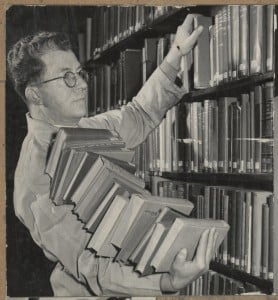 [Scenes of the State Library of Victoria from 1954 Age newspaper]; H27642a
[Scenes of the State Library of Victoria from 1954 Age newspaper]; H27642a
And here is what I found…
The Milk Dock
Flinders street station once had a milk dock. Fresh milk was delivered to Flinders Street by incoming trains from dairies all over Victoria. Milk cans were collected by railway staff and wheeled down the milk ramp on trolleys. Not everyone, it seems, was a fan of the process.
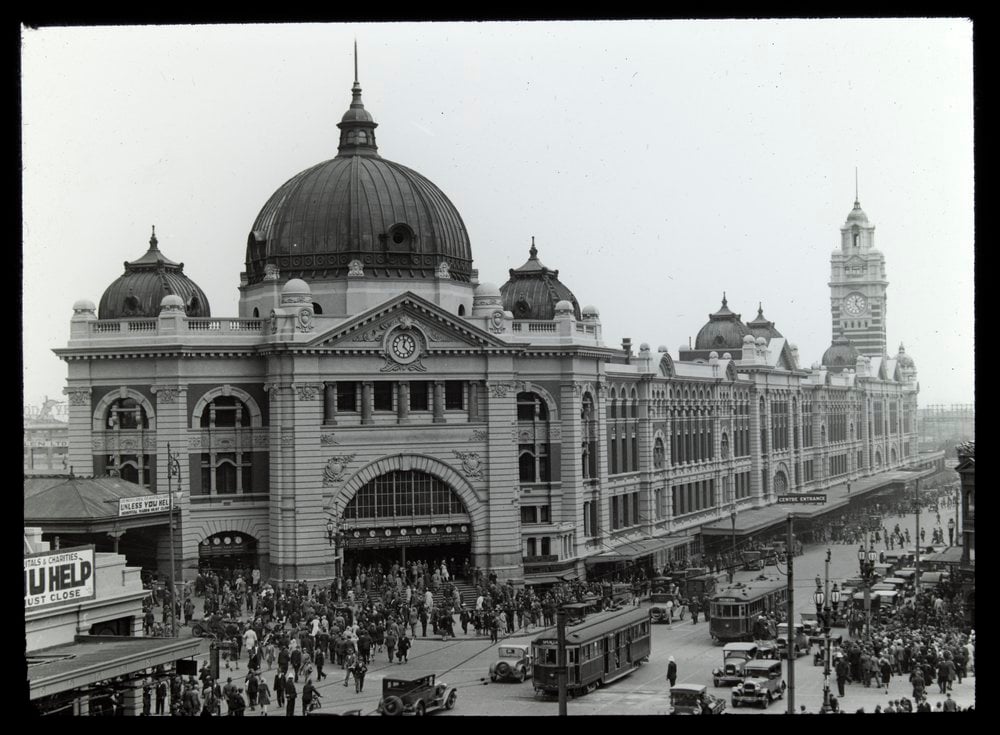 [Flinders Street Railway Station]; H2010.76/5
[Flinders Street Railway Station]; H2010.76/5
‘…[T]ired porters…drag goods trolleys almost every hour of the day’, complained The Argus in 1912. ‘Now and then a trolley gets out of hand, and “shoots the chute” in a wild rush, while the porters sprint behind it yelling warnings to those below. A man was knocked down and injured a few days ago. Some day, perhaps, someone will be killed’.
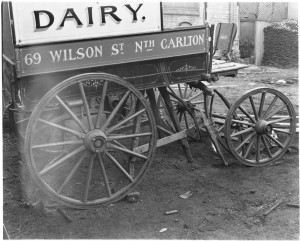 [Dairy wagon from 69 Wilson Street, North Carlton]; H92.20/1868
[Dairy wagon from 69 Wilson Street, North Carlton]; H92.20/1868
The chaos was not confined to the milk ramp. One commuter was so incensed that he penned a complaint to The Argus newspaper:
‘I lately followed a porter conveying a wooden truck, a crate of live fowls, and other baggage from a platform in Flinders Street to the cloakroom. He balanced them most insecurely on the top of some milk cans, with the result that both fowls and box somersaulted heavily on the platform… The same kind of thing can be noted any day’ (The Argus, 2 August 1917).
Once the milk cans were deposited (safely) at the bottom of the milk ramp, they were picked up by horses and carts, who distributed the milk to households across Melbourne. Later, the empty milk cans were returned to the station. They were cleaned, sorted and returned to the dairies.
 The Flinders–street viaduct – an anticipatory sketch [Melbourne, Vic.]; A/S21/03/89/40
The Flinders–street viaduct – an anticipatory sketch [Melbourne, Vic.]; A/S21/03/89/40
Banana Alley
In 1891 the railway viaduct was built on Flinders Street for the purpose of connecting Spencer Street and Flinders Street stations. The arches underneath the viaduct were enclosed and sub-divided into 33 separate spaces. You can see them on the left in the photograph below.
[View south east across Flinders Street towards Queens Bridge and Queens Wharf];H2008.105/11
The dark, cavernous conditions of the viaduct’s vaults made them an ideal place to ripen green bananas. They were quickly adopted as storage facilities by wholesale fruiterers from the nearby Western Market. The bananas were unloaded at Queen’s Wharf, before being transferred to the vaults for stockpiling and ripening.
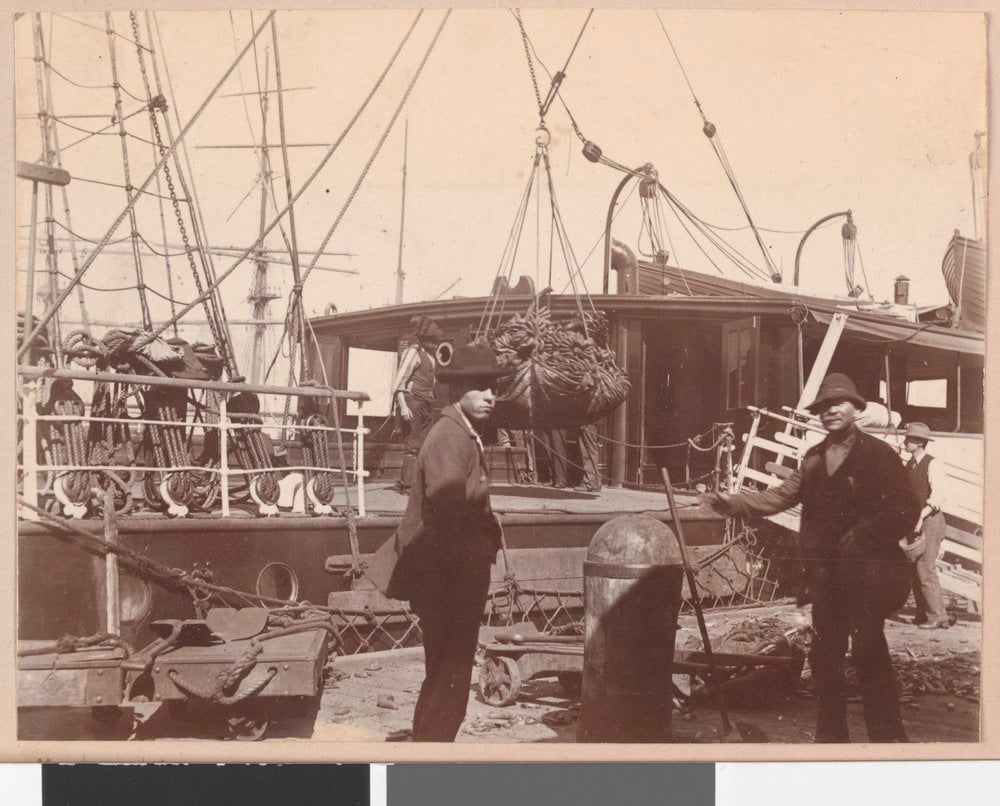 Unloading bananas, Queens Wharf, 1899 [Vic.]; H2006.188/3
Unloading bananas, Queens Wharf, 1899 [Vic.]; H2006.188/3
The bananas were full of all kinds of nasties: spiders, insects, snakes and rodents, who would hide inside their clustered hands. Inevitably, these creepy crawlies made their way into the vaults.
In the 1930s, Queen’s Wharf was no longer accessible to cargo ships due to the construction of the Queens Street bridge. The vaults fell into disrepair, but the legacy of the bananas remained. To this day, the precinct is known as ‘Banana Alley’ .
The little blue building
The little blue building was built some time in the 1920s, presumably at the behest of the Victorian Railways. Over the years, it’s been variously occupied by tobacconists, boot-makers, a dyer’s business, a shop selling oils and colours, an instrument repairer, newsagencies, an adult bookstore, book repairers, and even a scientific instruments shop. But despite the best efforts of the Sands & McDougall doorknockers, we are yet to discover the reason for the little blue building’s existence.
Do you know why it was built? We’d love to know.
Further reading
Davies, Jenny Beyond the facade : Flinders Street, more than just a railway station

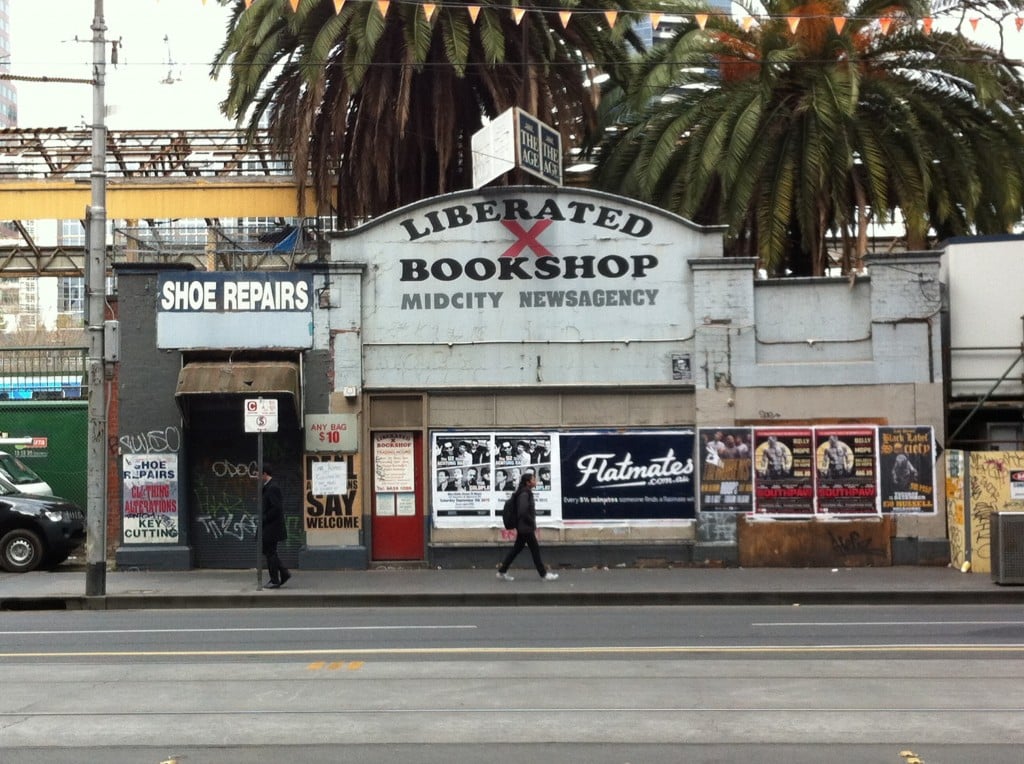
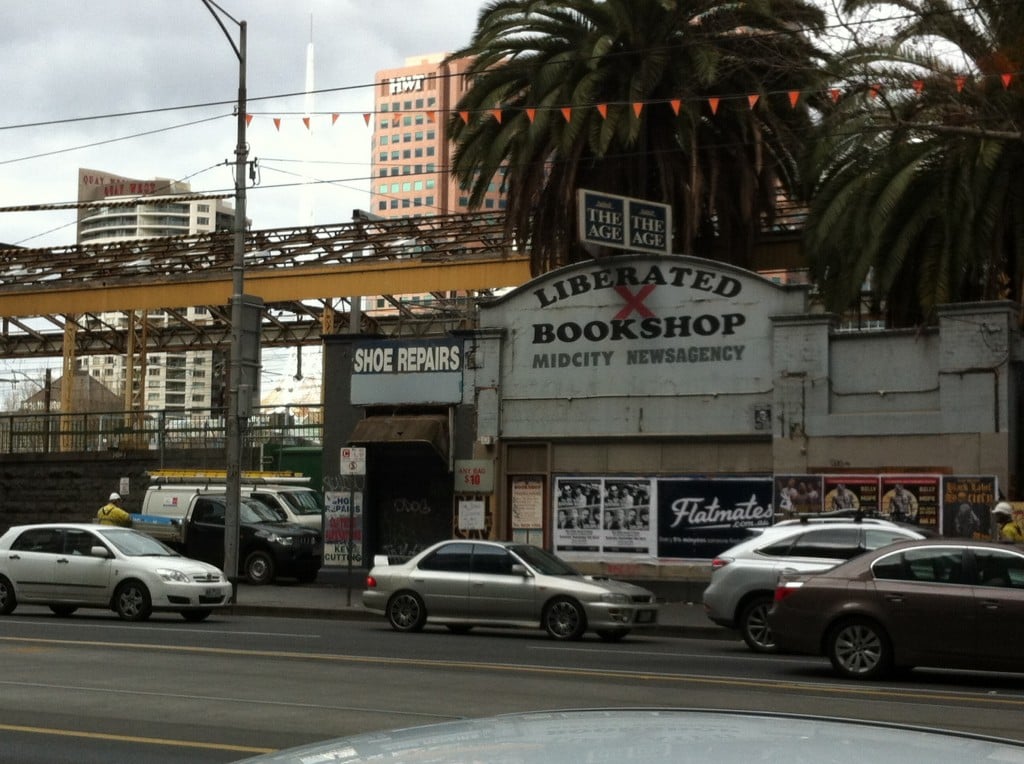

Dear Sarah,
Thank you for a most interesting piece of history.
Thank goodness we’ve still got such wonderful evocative names around Melbourne.
Happy Christmas,
Shirley Kidd
Hi Shirley,
I’m glad you enjoyed it. Have a great Christmas.
Sarah.
Hi Sarah,
Thank you for this. I used to party in Banana Alley years ago and always wondered why it was thus named. Mystery solved!
Have a great Christmas,
Sylvia
Hi Sylvia,
I’m glad they retained its original name. Otherwise my interest may not have been sparked in the first place!
Merry Christmas.
Sarah
Sarah – how beaut to “hear” from you in this fashion! And yes, Jenny Davies’ book is thoroughly recommended for all lovers of Melbourne’s history. Someone must know the origins of the Little Blue Building – Rohan Storey?!?
All the best for Christmas and the New Year –
Judy
Thanks Judy. The building is so underwhelming that I can see how its origins may have slipped through the cracks. But that’s why I found it so interesting! Merry Christmas to you too … Sarah
I love snippets of information about Melbourne like this!
Perhaps Melbourne City Council’s records would contain some information about the building. (Or was the MCC established later …?)
Thank you, Sarah, for your evocative piece. I remember during the 1990s taking shoes to be repaired to the shoemaker there when I worked at the nearby Victoria University Campus. I also remember lunching at a restaurant in one of the vaults, again in the late 80s/early 90s. If I am right there were several restaurants there before Southgate was established and swallowed any nearby competition.
Thank you Sarah : I’m delighted with your information, I knew a little bit about banana alley one of my friends use to train at the gym now in place.
I hope the little shop could be restore en put into good use again .
Happy New Year Beatriz
I think it may have been the construction of the Spencer St bridge in about 1928-30 which made the Queen St wharf unusable.
Thanks for an interesting read. I was looking for the bakery owned by painter Fred McCubbin’s father. Apparently its foundations are now under the widened roadway at the intersection of Burke and King Sts. The original roadway was probably where the tram tracks are and the road widening and footpath has apparently swamped the foundations, as the current street numbers in King St have a large gap there.
Am I correct in my assumptions?
Regards,
Rob
Hi Rob,
The City of Melbourne has produced an online interactive map that might help you answer this question. The site includes an option to overlay the 1895 MMBW Detailed Plan for City of Melbourne, so that you can compare the city’s properties and landmarks from 1895 to the city and streets as they exist today.
Just enter the name of the streets in the Search box at the top of the page and choose from the list of corresponding locations. The map will centre on your chosen location, and you can zoom in and out on it. Then select ‘Historic Maps’ from the tabs on the left hand side and choose ‘1895 MMBW Detailed Plan’. You can then alternate between the two to make comparisons between 1895 and today.
Sarah
Terrific article; I’ve been past banana alley many times and wondered how it gained the name. Many thanks, gh
I used to go to a nightclub called sugar shak in a banana alley vault in the 1990s. It was very claustrophobic!
thanks for this story.
Is that the spire of our long lost Fish Market in Flinders Street in the distance west of the viaduct’s arches ?
I believe it was pulled down around the year I first started exploring the City… maybe 1965.
I used to come from Heidelberg out of Princes Bridge Station (platform 13 or 14 now a theatre in the bottom of the Ian Potter Gallery !) and cross to the arch up the steps next to the Cathedral, then on to “Tim the Toyman’s” and into the City…
so I never saw the Fish Market.
So-o-o much has been pulled down since then !
According to Heather Chapman and Judith Stillman’s great book ‘Melbourne. Then and Now’ the Fish Market was demolished in 1958 to make way for a second rail viaduct. Such a shame, as by all accounts it was a wonderful building. You can see it here.
What a lovely post! So many avenues (rabbit-holes) of research to follow from here!
Thanks for the recommendations of web sites and books in the comments too, great Summer fun.
Terri.
Very interesting story. Here’s a little more from a couple of years ago:
http://www.walkingmelbourne.com/forum/viewtopic.php?f=3&t=7341&sid=4032e0b0a33934a88981df21c21aa799&start=0
Also:
http://www.flindersstreetstation.com.au/banana-alley-stories.php
Thanks Sarah. As I couldn’t see from the photo why the building was called “The Little Blue Building”, I thought the moniker was due to the Liberated Bookshop there.
John Conroy ran Midcity Newsagency for many years – one of several CBD newagencies he operated until only recently, with the obligatory and very profitable adult bookshops.
Hi Petrina, Great suggestion. I never thought of that! ‘The Little Blue Building’ was simply the description the patron who asked the original question about the building gave me. It’s not an official title. And one could argue that the building is more grey than blue … Sarah.
Love reading all this magicical information… Thank you always… 🙂
Hi Sarah Matthews,
I loved your article and have tried to do my own research on ‘The Little Blue Building’. Have you found out any more information about it?
Hi Phoebe, I’m glad you enjoyed it. No, I haven’t had a chance to do any more research on the little blue building. The Public Records Office of Victoria (PROV) holds the plans for public buildings and railway station buildings, so you would probably the find the answer there. Sarah.